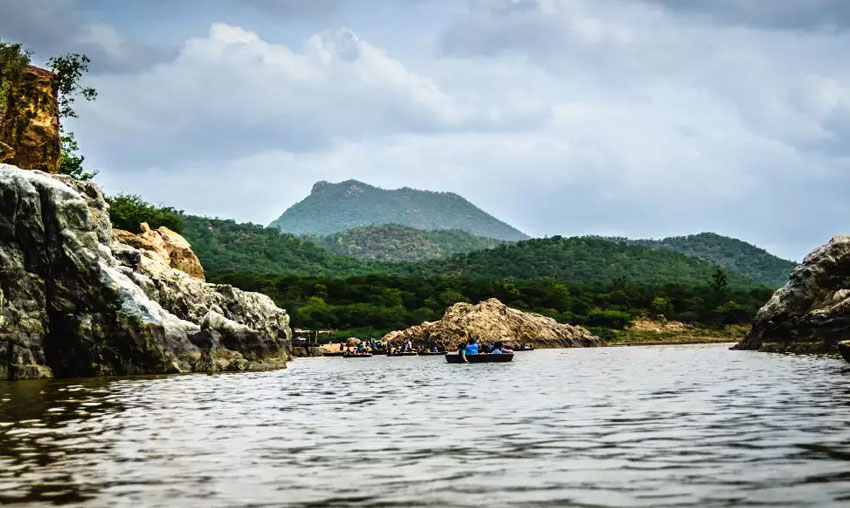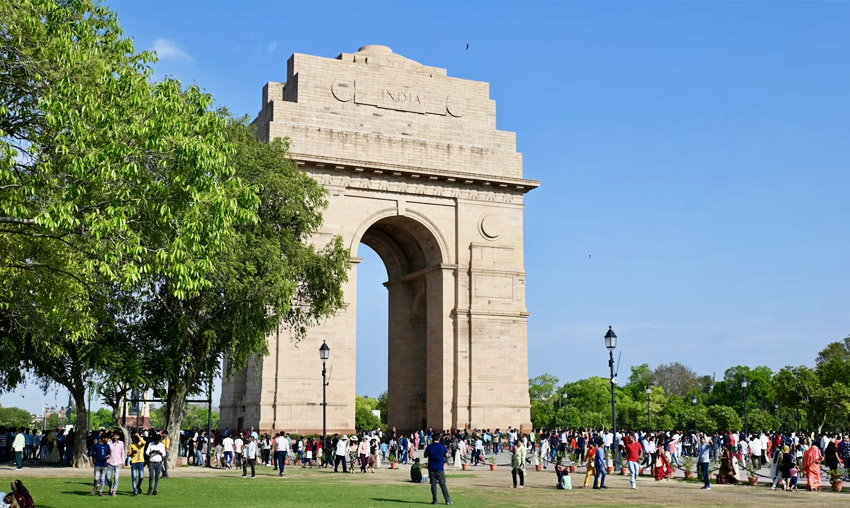September 15, 2024
The Top 15 Stunning Indian UNESCO World Heritage Sites
There are 40 UNESCO World Heritage sites in India: 32 are cultural, 7 are natural, and 1 is mixed. These are but a small portion of India’s rich cultural and natural legacy; the country is among the most geographically and culturally diversified in the world. These 19 amazing Indian UNESCO World Heritage sites are only the beginning.
A wide range of locations are featured on this list, including historical temples, natural wonders, Mughal buildings, Buddhist artwork, and Indian national parks. But this is only the beginning in terms of India. When visiting India, tourists are presented with an incredible variety of Indian landmarks, experiences, and natural, historical, religious, and cultural landmarks. Many of India’s historic structures and monuments are not on the list of UNESCO World Heritage Sites; a small number are preserved but not protected by the Archaeological Society of India (ASI). It’s just that there are too many.
They are all quite remarkable. India is endowed with both man-made and natural treasures because it is a subcontinent with a long history. Even after more than 17 years of blogging about travel to India, I still feel like I haven’t seen everything. I believe that seeing all of India, or even just the majority of it, would take several lives.
Note: Some of these sites can be combined with a Weekend getaway from Delhi.
1. Taj Mahal
Rabindranath Tagore, the poet and novelist known as India’s Shakespeare, described the Taj Mahal as a “teardrop on the face of eternity.” Naturally, this global marvel—widely regarded as the most exquisite structure ever built—is well recognized. Without the Taj Mahal, no list of India’s historical sites would be complete. It is the country’s most iconic landmark. It’s also among the most well-liked tourist destinations worldwide.
However, a lot of people are unaware that the Taj Mahal is actually a tomb. The Mughal emperor Shah Jahan built it in the middle of the 17th century as a memorial to his wife Mumtaz, who passed away giving birth to their fourteenth child. The symmetry of the building, architectural feats like the raised platform supporting it, and the way the white marble changes color and shines in response to the light of day and the weather all contribute to the Taj Mahal’s beauty and distinctiveness. When they see the Taj Mahal for the first time, the majority of visitors exhibit a kind of happiness that is clearly visible on their faces. It is absolutely essential to see.
The Taj Mahal is the highlight of every Golden Triangle tour.
2. Humayun’s Tomb
Delhi offers a Lost of activities to do in Delhi to enjoy. The city is endowed with several historic and cultural structures, tombs, forts, and temples in addition to three UNESCO sites. Indeed, it is among the oldest cities in the world. At least seven eras have called this city home, including the British and Mughal empires. Of the three UNESCO sites, Humayun’s Tomb (constructed in 1570 during the Mughal era) has undergone the most exquisite restoration. (the other two are Qutb Minar and Red Fort)
Approximately eighty years before the Taj Mahal, this garden tomb was the first on the Indian subcontinent. Under the patronage of his son, the great Emperor Akbar, who was just 13 years old when his father died after falling down a flight of stairs, the tomb was constructed in honor of the Mughal emperor Humayun. The massively designed mausoleum of Humayun is encircled by vast lawns and gardens. It is situated in a highly significant archeological area of Delhi because of the close-by mausoleum of the Sufi saint Hazrat Nizamuddin, who lived in the fourteenth century, and the abundance of medieval Islamic structures.
3. Qutb Minar

There are many amazing buildings and monuments in Delhi, but only three UNESCO World Heritage sites include the Qutb Minar. With great cultural and historical significance, this monument is truly spectacular.
At 73 meters, the Qutb Minar—whose name means “tower”—is among the world’s highest brick minarets. There are elaborate sculptures on each of the minaret’s five stories.
In addition, it’s among the greatest and earliest instances of Indo-Islamic building. The Qutb-ud-din Aibak, the first Muslim king of Delhi, began building the Qutb Minar in 1193. Thus, Delhi’s first mosque was Qutb Minar.
The top three stories of the minaret are composed of marble, while the base is composed of red sandstone. Beautiful inscriptions and motifs, such as Quranic phrases, Hindu deities, and floral patterns, are adorning it.
Apart from the Qutb Minar, the vicinity boasts of numerous other noteworthy and historically significant edifices, including as the Alai Darwaza Gate and the seven-meter-tall Iron Pillar of Delhi, which is renowned for its ability to withstand corrosion and rust.
4. Red Fort (Lal Qila)
Red Fort, commonly called Lal Qila, is situated in Old Delhi. It was classified as one of Delhi’s three UNESCO World Heritage Sites in 2007. Red Fort is regarded as a symbol of India and has seen numerous significant events over the years. India’s 500 rupee note features a picture of Red Fort, designating the location as culturally significant.
The fort took ten years to construct and was ordered by Mughal Emperor Shah Jahan in 1638 when he decided to relocate his capital from Agra to Delhi. The fort was formerly known as Qila-i-Mubarak, or the Blessed Fort, because it served as the Mughal Emperors’ primary home. The massive red sandstone border walls of the fort led to the eventual change of its name to Lal Qila.
Within the Red Fort complex are numerous palaces and museums. It is accessible to guests from Tuesday through Sunday from 9:30 AM to 4:30 PM. Winter (October to February) is the ideal time to visit the fort because of the nice weather. It is best to reserve and purchase the entrance ticket online in advance to avoid a long line at the ticket office because the fort is frequently extremely crowded. Make sure you have a legitimate official ID on you in case you need it verified.
5. Fatehpur Sikri
A UNESCO World Heritage Site with an intriguing history, Fatehpur Sikri is one of the most underappreciated sights in India’s Golden Triangle.
This abandoned city is conveniently located 40 km from Agra and 200 km from Jaipur, making it a great addition to any Golden Triangle itinerary. The ideal method to accomplish this is to make a stop at Fatehpur Sikri when traveling from Agra to Jaipur.
But what is it that makes Fatehpur Sikri so extraordinary?
This splendid city, founded in the 16th century by Emperor Akbar, was the capital of the Mughal Empire for barely over ten years before it was abandoned because of a shortage of freshwater. Its red sandstone buildings are astonishingly well preserved to this day.
As you stroll around the complex, you’ll be met by a fusion of architectural forms that honor religious plurality and combine Islamic, Persian, and Hindu influences. Akbar was an admirer of these influences. You might easily spend three hours trying to see everything, passing through mosques, courtyards, and palaces.
Panch Mahal, a five-story palace in the middle of the castle that served as the royal family’s retreat, is the most striking feature of Fatehpur Sikri. Supported by 176 finely carved columns, the edifice looks out over a lovely ornamental pool.
For those who enjoy history, architecture, photography, and exploration, Fatehpur Sikri is a must-visit location. It provides a unique chance to discover some of the Mughal era’s ruins.
You don’t have to spend a fortune on travel expenses in India. Foreign visitors to Fatehpur Sikri must pay 550 rupees to enter the complex, but locals just need to pay 35 rupees. Everyone is free to enter Jama Masjid, the on-site mosque.
6. Khajuraho Group of Monuments
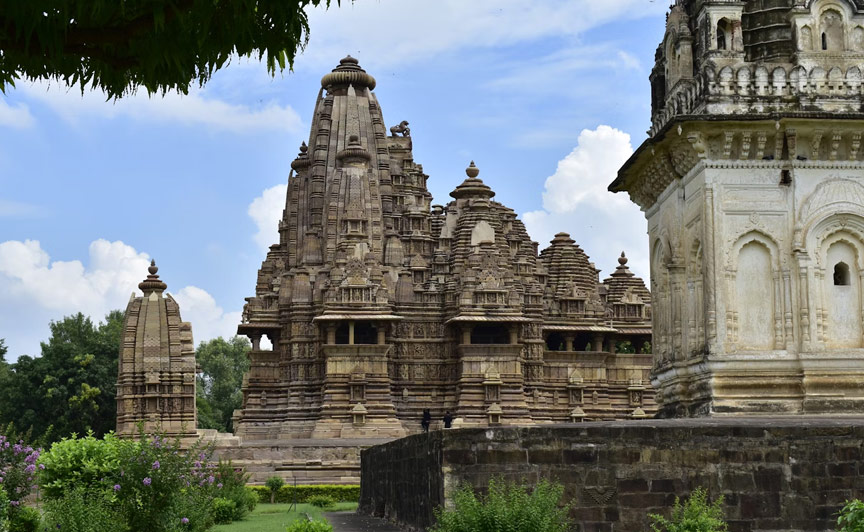
One of the most visited tourist destinations in the Indian state of Madhya Pradesh, located in the center, is Khajuraho. Three sets of temples can be found in this sleepy, laid-back town; the western set is the most visited and impressive. The temples of Khajuraho, which are associated with both Hinduism and Jainism, were constructed approximately a millennium ago, under the Chandella dynasty.
Among the greatest works of Indian art, the temples strike the ideal balance between building and sculpture. Both of them have exquisite designs and are adorned with detailed carvings created by the best sculptors. The expertly carved images depict a variety of human experiences, including sexuality.
Khajuraho is most known for its so-called “erotic” engravings, though many people think this interpretation is incorrect. The carvings, which were made after the Kama Sutra was published, most likely weren’t meant to be educational; rather, they were meant to symbolize some of the numerous human cravings and experiences that followers of the Sutra must endure in order to achieve spiritual connection with the divine. Some believe that rather than just sensuous pleasure, the faces depict divine bliss. Significantly, the carvings celebrate feminine beauty and sensuality in an unrestrained manner.
7. Group of Monuments at Hampi
Hampi is a marvel, one of the world’s underappreciated wonders that merits much more attention. Scattered across roughly 25 square kilometers, this enormous, opulent, deserted metropolis is located in the Southern Indian state of Karnataka. Nestled amidst striking rocky hills and bordering the Tungabhadra River, the city showcases the remnants of around 1,600 extant Dravidian forts, temples, shrines, palaces, and an assortment of other buildings. Constructed by wealthy aristocrats throughout the 14th and 16th centuries, Hampi served as the capital of the Vijayanagara Empire, the final great Hindu kingdom. The Deccan Muslim invaders burned and pillaged it in parts in 1565.
Seeing the entire city may take up to a week. It’s a wonderful spot to unwind, take in the serene surroundings, and visit an important archaeological site all at once. Under the Vijayanagara Empire, Dravidian architecture flourished and the ruins are absolutely magnificent, with vast dimensions,
tall towers and ornate columns. You can take a coracle, a small, round boat that resembles a basket, to see some of the temples that are only reachable by river. There are also a number of hilltop temples that provide fantastic views of the sunrise and sunset.
8. Ellora and Ajanta Caves
Despite being two distinct UNESCO sites, the Ellora and Ajanta Caves are both in Maharashtra, close to Aurangabad. Most visitors spend two days there, spending a day at each location. They differ greatly in almost every other aspect, too, apart from the fact that they are both collections of caves located in the same area.
The two kilometers of Ellora Caves are carved out of the side of a tall basalt cliff. The temple sanctuaries are dedicated to Buddhism, Hinduism, and Jainism and date back to the year 600 or 1,000 A.D. The Kailasa Temple is the focal point and is exceptional in every way. It had to be practically chiseled out of the cliff, removing over 220,000 tons of rock. Kailasa, shaped like a gigantic chariot, is covered with sculptures that represent scenes from the Ramayana and Mahabharata, two of the greatest Hindu epics.
The majority of the Ajanta Caves’ contents are cave paintings, and they are older and smaller than the Ellora Caves. More were added in the fifth and sixth centuries, with the oldest dating from the first and second centuries. They are regarded as masterworks of Buddhist art and portray events from the life of the Buddha. The magnificent Ellora and Ajanta Caves are well worth the trip.
9. Konark Sun Temple
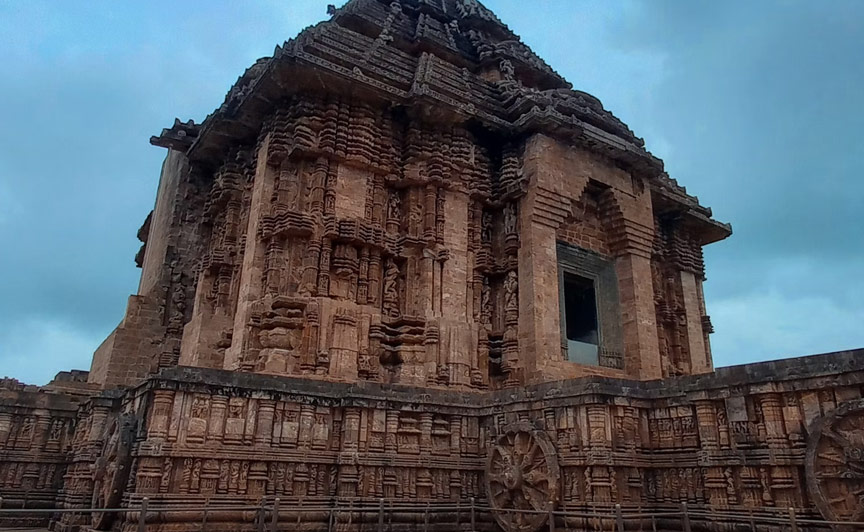
The Konark Sun Temple, the most popular tourist destination in Odisha, is a Hindu temple devoted to the Sun God Surya. In 1250 CE, King Narasimhadeva I of the Eastern Ganga Dynasty erected it as a celebration of his triumph over the Mamluk Dynasty’s Muslim monarch.
About 1,200 artisans worked for 12 years to create the magnificent architectural work of art that you see today. The significance of Konark Sun Temple in Indian culture and history led to its induction as a World Heritage Site by UNESCO in 1984.
Konark Sun Temple, constructed from Khondalite stones, is a singular specimen of Kalinga architecture. It is a representation of the Sun God’s chariot, which has 24 stone wheels and is drawn by seven horses. The wheels stand for the hours of the day, the horses stand for the days of the week, and the pairs of wheels symbolize the months of the year. The major temple’s deity would receive the first light from the sun thanks to the way it was built.
The temple’s walls and base are decorated with elaborate carvings and sculptures. Hindu deities, celestial women, legendary characters, animals, sensuality, and men and women going about their everyday business are all featured in their stories of the lives and times during the Kalinga era.
The building is in dire need of repair since it is about to collapse. The degradation is obvious even though the government is replacing the disintegrating pieces with new, boring bricks in an effort to preserve the masterpiece. Still, tourists are enthralled by the monument’s ethereal and artistic splendor.
10. Elephanta Caves
Elephanta Island, where the Elephanta Caves are situated, is accessible by boat from Mumbai’s Gateway of India. There are many historic archaeological sites on the little island that go all the way back to the second century B.C. Five historic temples from the fifth and sixth centuries can be found in the Elephanta Caves. You can see a mixture of Buddhist stupas and Hindu temples throughout the island since it was during a period when Buddhism was beginning to decline and other religions were beginning to expand throughout India.
From the Gateway of India, you may get to the caves in about one hour. You can choose to walk or take the train to the base of the stairs leading up to the caves after you arrive on the small island. Although climbing more than a hundred stairs in the hot, muggy weather can be difficult, there are a number of stores along the route where you can stop for refreshments.
The Hindu deity Shiva is honored at the temples, which are carved out of solid basalt rock. Of the five Hindu temples, the main temple is the most striking because the majority of the other artworks have been vandalized or ruined. It has sculptures made of rock-cut stone, most of which are in high relief and show Shiva as the three-faced Shiva, the Lord of Dance, or the Lord of Yoga.
11. The Churches and Convents of Goa
In India, the Churches and Convents of Goa are among the most recognizable UNESCO World Heritage monuments. The churches in this collection date back to Goa’s Portuguese occupation in the sixteenth century. Ella, a settlement, became the capital of the Portuguese, who constructed numerous exquisite chapels, churches, convents, and cathedrals there. While the building was tailored to the local environment, it was influenced by European architectural movements like Baroque and Gothic, resulting in an ash-brown fusion. There are currently just seven of these structures remaining, and they are all located in what is now called Old Goa.
The mortal bones of Goa’s patron saint, Saint Francis Xavier, are kept in the Bom Jesus Basilica. Every year on December 3rd, the feast is observed. It is a grand occasion that includes numerous festivals and religious ceremonies.
The St. Augustine Tower and the Se Cathedral are two more fascinating sites to see in Old Goa. Unlike the other churches, the St. Augustine Tower is not a functioning place of worship but rather a protected ruin.
The churches and convents of Goa are easily accessible from Panjim, the state’s capital, as well as from throughout the little state. The Goan way of life has long included yearly visits to these churches, particularly for the local Catholic population. I used to go there with my grandma when I was a tiny child, and these days I take my kids.
12. The Great Living Chola Temples
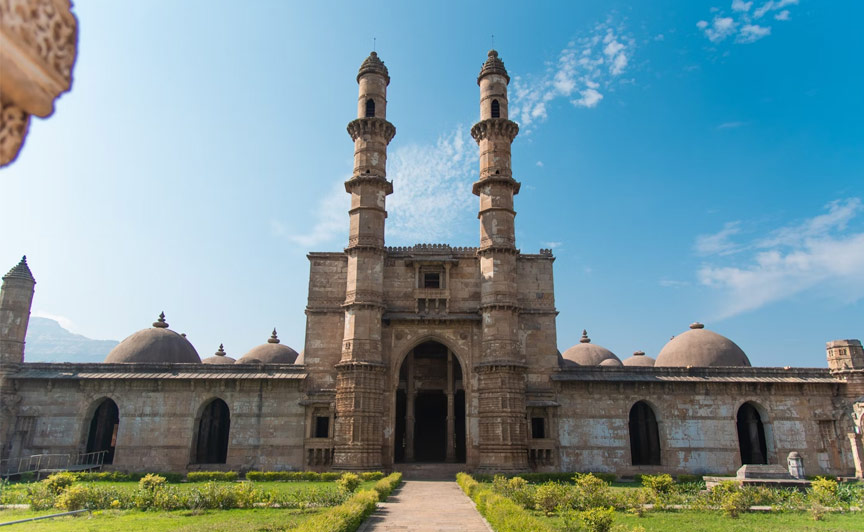
Three Dravidian temples constructed in the eleventh and twelfth century by the Chola kingdom make up the Great Living Chola temples. They are outstanding illustrations of the Chola dynasty’s architectural wonders.
The temples are in the southern Indian state of Tamil Nadu. The trio of temples consists of:
- the Brihadeeshwara temple in Thanjavur,
- the Airvateshwara temple in Darasuram, Kumbakonam,
- the Brihadeeshwara temple at Gangaikonda Cholapuram.
The two temples in Thanjavur are equally spectacular and a must-see, even though the former is the most well-known and was the first to be listed as a Unesco World Heritage site. Though all three are devoted to the Hindu deity Shiva, other gods like Ganesha, Shakti, and Vishnu are also represented in the temple complexes.
The three Chola temples have become more well-known as a result of the recent blockbuster films in India that have reignited interest in the Chola empire. Bangalore and Chennai are roughly a 6-to 8-hour drive away from all three temples. The ideal course of action is to start and end your trip at different temples in Thanjavur.
13. Champaner Pavagadh
The remarkable, and often overlooked, Champaner Pavagadh was recognized as a UNESCO World Heritage site in 2004 due to its exceptional blend of Hindu and Muslim architectural styles. Champaner Pavagadh was a city in Gujarat during the 16th century. Though the exhibited cultures have long since vanished, Hindus still frequent the location as a popular place of pilgrimage.
Other than pilgrims, you won’t see many people at Champaner Pavagadh despite its magnificent architecture. The Jami Masjid is usually incredibly beautiful and deserted. The grandeur of this amazing location is enhanced by the absence of tourists. From the top of Kevda Masjid, you’ll find one of the best views that will give you an overview of the entire site.
Get the Archaeological Society of India guidebook when you visit Champaner Pavagadh; it has a ton of information that will help you navigate the site and make sense of what you’re seeing.
Vadodara, Gujarat, is the closest city to Champaner Pavagadh. The day trip from Ahmedabad, the capital, is somewhat lengthy. Although Champaner Pavagadh can be reached by local busses, driving there is advised due to its size, best done in a car with a driver from Vadodara. If you decide to take a bus, a driver will be available to transport you around the location in an autorickshaw.
14. Kakatiya Rudreshwara (Ramappa) Temple, Telangana
near the State of Telangana, near the village of Palampet, around 200 kilometers northeast of Hyderabad, sits Rudreshwara, also called Ramappa Temple. During the Kakatiyan dynasty (1123-1323 CE), the major Shiva temple within a walled complex was constructed by Rudradeva and Recharla Rudra, the emperors. The sandstone temple’s construction is thought to have lasted for about 40 years, starting in 1213 CE.
The edifice has carved granite and dolerite pillars and beams that are embellished, as well as a unique pyramid-shaped Vimana (horizontally stepped tower) constructed of lightweight porous bricks, sometimes known as “floating bricks,” which lessened the weight of the roof structures. The exquisite sculptures inside the temple depict local dancing traditions and Kakatiyan culture. Situated near the shores of the Ramappa Cheruvu, a water reservoir constructed by the Kakatiya, the temple was built in accordance with the ideology and practice supported by dharmic texts, which states that temples should be built as an integral part of a natural setting, which includes hills, forests, catchment areas, streams, lakes, springs, and agricultural lands.
15. The Jantar Mantar, Jaipur
An observatory for astronomy located in Jaipur, the Jantar Mantar was constructed in the early 1700s. There are about twenty primary stationary instruments in all. These are massive masonry representations of well-known instruments, many of which have unique qualities of their own. Specifically designed to allow for the visual observation of celestial positions, they have a number of innovative architectural and technical features. Out of all the historical observatories in India, this one is the most important, the most complete, and the best preserved. It is a manifestation of the cosmological ideas and astronomical knowledge of a learned prince’s court at the close of the Mughal era.
Latest Blogs
-
Best Tourist Places to Visit near Bangalore Within 100 kms
March 25, 2025
-
Pet Friendly Luxury Resorts near Mumbai for Family
March 22, 2025
-
Pet friendly Resorts near Delhi within 100 kms
March 18, 2025
-
Best Tourist Places to Visit near Delhi
March 15, 2025
-
Top 10 bikes for touring in India
March 12, 2025
-
12 Jyotirlinga Name and Place – Timing & How to reach
February 26, 2025
-
10 Popular Buddhist Temples & Monasteries to Visit in India
October 15, 2024
-
You must opt-in Things to Do when traveling to India
September 27, 2024
-
Adventure Awaits: Exploring Kochi’s Exciting Sports Activities
September 25, 2024
-
Unleash Your Adventurous Spirit with Leh Ladakh Bike Tour Packages
September 19, 2024

